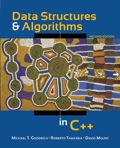
Data structures and algorithms in C++
2nd Edition
ISBN: 9780470460443
Author: Goodrich
Publisher: WILEY
expand_more
expand_more
format_list_bulleted
Question
Chapter 4, Problem 2P
Program Plan Intro
Experimental analysis
Program plan:
- Declare header file.
- Declare namespace.
- Define the method “Ex1()”,
- Declare the variable.
- Set the first array value.
- Execute till “n-1”,
- Update sum value.
- Return sum value.
- Define the method “Ex2()”,
- Declare the variable.
- Set the first array value.
- Execute for “i” value from “2” to “n-1”,
- Update sum value.
- Return sum value.
- Define the method “Ex3()”,
- Declare and initialize the variable.
- Execute for “i” value from “1” to “n-1”,
- Update sum value.
- Execute for “j” value from “1” to “i”,
- Update sum value.
- Return sum value.
- Define the method “Ex4()”,
- Declare and initialize the necessary variables.
- Execute for “i” value from “1” to “n-1”,
- Update sum value.
- Update “t” value.
- Return “t” value.
- Define the method “Ex5()”,
- Declare and initialize the variable.
- Execute for “i” value from “0” to “n-1”,
- Declare and initialize the variable to “0”.
- Execute for “j” value from “0” to “n-1”,
- Update sum value.
- Execute for “k” value from “1” to “j”,
- Update the sum value.
-
- Check whether first value of second array is same as sum,
- If it is true, increment “c” value.
- Check whether first value of second array is same as sum,
- Return “c” value.
- Define the method “main()”,
- Declare the necessary array variables.
- Execute for “i” value from “0” to “n-1”,
- Update both array values.
- Construct two clock objects.
- Declare the variable.
- Initialize “t1” object.
- Assign the value returned from “Ex1()”.
- Initialize “t2” object.
- Compute the difference of two object values.
- Compute seconds.
- Print seconds.
- Initialize “t1” object.
- Assign the value returned from “Ex2()”.
- Initialize “t2” object.
- Compute the difference of two object values.
- Compute seconds.
- Print seconds.
- Initialize “t1” object.
- Assign the value returned from “Ex3()”.
- Initialize “t2” object.
- Compute the difference of two object values.
- Compute seconds.
- Print seconds.
- Initialize “t1” object.
- Assign the value returned from “Ex4()”.
- Initialize “t2” object.
- Compute the difference of two object values.
- Compute seconds.
- Print seconds.
- Initialize “t1” object.
- Assign the value returned from “Ex5()”.
- Initialize “t2” object.
- Compute the difference of two object values.
- Compute seconds.
- Print seconds.
- Return “0”.
Expert Solution & Answer
Want to see the full answer?
Check out a sample textbook solution
Chapter 4 Solutions
Data structures and algorithms in C++
Ch. 4 - Prob. 1RCh. 4 - Prob. 2RCh. 4 - Prob. 3RCh. 4 - Draw the recursion trace of the Power algorithm...Ch. 4 - Prob. 5RCh. 4 - Prob. 7RCh. 4 - Prob. 8RCh. 4 - Prob. 9RCh. 4 - Prob. 10RCh. 4 - Prob. 11R
Ch. 4 - Prob. 12RCh. 4 - Prob. 13RCh. 4 - Prob. 14RCh. 4 - Prob. 15RCh. 4 - Prob. 16RCh. 4 - Prob. 17RCh. 4 - Prob. 18RCh. 4 - Prob. 19RCh. 4 - Give a big-Oh characterization, in terms of n, of...Ch. 4 - Prob. 21RCh. 4 - Prob. 23RCh. 4 - Prob. 24RCh. 4 - Prob. 25RCh. 4 - Prob. 26RCh. 4 - Prob. 27RCh. 4 - Prob. 28RCh. 4 - Prob. 29RCh. 4 - Prob. 30RCh. 4 - Prob. 31RCh. 4 - Prob. 32RCh. 4 - Prob. 33RCh. 4 - Prob. 34RCh. 4 - Prob. 35RCh. 4 - Prob. 36RCh. 4 - Prob. 37RCh. 4 - Prob. 38RCh. 4 - Prob. 39RCh. 4 - Describe a recursive algorithm to compute the...Ch. 4 - Prob. 4CCh. 4 - Prob. 5CCh. 4 - Prob. 6CCh. 4 - Prob. 7CCh. 4 - Prob. 8CCh. 4 - Prob. 9CCh. 4 - Prob. 10CCh. 4 - Prob. 11CCh. 4 - Prob. 12CCh. 4 - Prob. 13CCh. 4 - Prob. 14CCh. 4 - Prob. 15CCh. 4 - Prob. 16CCh. 4 - Consider the Fibonacci function, F(n) (see...Ch. 4 - Prob. 18CCh. 4 - Prob. 19CCh. 4 - Prob. 20CCh. 4 - Prob. 21CCh. 4 - Prob. 22CCh. 4 - Prob. 23CCh. 4 - Prob. 24CCh. 4 - Prob. 25CCh. 4 - Prob. 26CCh. 4 - Prob. 27CCh. 4 - Implement prefixAverages1 and prefixAverages2 from...Ch. 4 - Prob. 2PCh. 4 - Prob. 3P
Knowledge Booster
Recommended textbooks for you
 Database System ConceptsComputer ScienceISBN:9780078022159Author:Abraham Silberschatz Professor, Henry F. Korth, S. SudarshanPublisher:McGraw-Hill Education
Database System ConceptsComputer ScienceISBN:9780078022159Author:Abraham Silberschatz Professor, Henry F. Korth, S. SudarshanPublisher:McGraw-Hill Education Starting Out with Python (4th Edition)Computer ScienceISBN:9780134444321Author:Tony GaddisPublisher:PEARSON
Starting Out with Python (4th Edition)Computer ScienceISBN:9780134444321Author:Tony GaddisPublisher:PEARSON Digital Fundamentals (11th Edition)Computer ScienceISBN:9780132737968Author:Thomas L. FloydPublisher:PEARSON
Digital Fundamentals (11th Edition)Computer ScienceISBN:9780132737968Author:Thomas L. FloydPublisher:PEARSON C How to Program (8th Edition)Computer ScienceISBN:9780133976892Author:Paul J. Deitel, Harvey DeitelPublisher:PEARSON
C How to Program (8th Edition)Computer ScienceISBN:9780133976892Author:Paul J. Deitel, Harvey DeitelPublisher:PEARSON Database Systems: Design, Implementation, & Manag...Computer ScienceISBN:9781337627900Author:Carlos Coronel, Steven MorrisPublisher:Cengage Learning
Database Systems: Design, Implementation, & Manag...Computer ScienceISBN:9781337627900Author:Carlos Coronel, Steven MorrisPublisher:Cengage Learning Programmable Logic ControllersComputer ScienceISBN:9780073373843Author:Frank D. PetruzellaPublisher:McGraw-Hill Education
Programmable Logic ControllersComputer ScienceISBN:9780073373843Author:Frank D. PetruzellaPublisher:McGraw-Hill Education

Database System Concepts
Computer Science
ISBN:9780078022159
Author:Abraham Silberschatz Professor, Henry F. Korth, S. Sudarshan
Publisher:McGraw-Hill Education

Starting Out with Python (4th Edition)
Computer Science
ISBN:9780134444321
Author:Tony Gaddis
Publisher:PEARSON

Digital Fundamentals (11th Edition)
Computer Science
ISBN:9780132737968
Author:Thomas L. Floyd
Publisher:PEARSON

C How to Program (8th Edition)
Computer Science
ISBN:9780133976892
Author:Paul J. Deitel, Harvey Deitel
Publisher:PEARSON

Database Systems: Design, Implementation, & Manag...
Computer Science
ISBN:9781337627900
Author:Carlos Coronel, Steven Morris
Publisher:Cengage Learning

Programmable Logic Controllers
Computer Science
ISBN:9780073373843
Author:Frank D. Petruzella
Publisher:McGraw-Hill Education